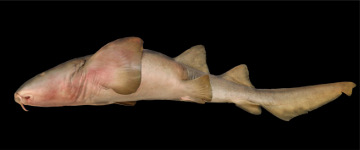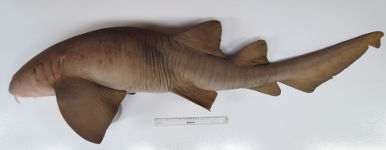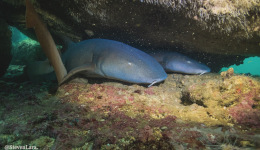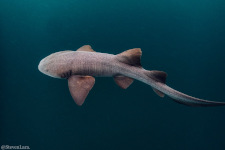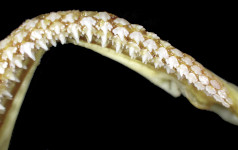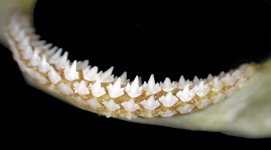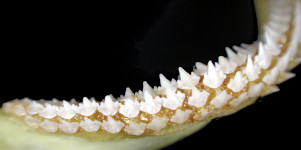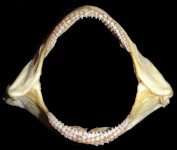Ginglymostoma unami
Del Moral-Flores, Ramírez-Antonio, Angulo & Pérez-Ponce De León, 2015
Classification: Elasmobranchii Orectolobiformes Ginglymostomatidae
Reference of the original description
Ginglymostoma unami sp. nov. (Chondrichthyes: Orectolobiformes: Ginglymostomatidae): una especie nueva de tiburón gata del Pacífico oriental tropical. [Ginglymostoma unami sp. nov. (Chondrichthyes: Orectolobiformes: Ginglymostomatidae): a new species of nurse shark from the Tropical Eastern Pacific]. Revista Mexicana de Biodiversidad, 86, 48–58
Ginglymostoma unami sp. nov. (Chondrichthyes: Orectolobiformes: Ginglymostomatidae): una especie nueva de tiburón gata del Pacífico oriental tropical. [Ginglymostoma unami sp. nov. (Chondrichthyes: Orectolobiformes: Ginglymostomatidae): a new species of nurse shark from the Tropical Eastern Pacific]. Revista Mexicana de Biodiversidad, 86, 48–58
Image of the original description
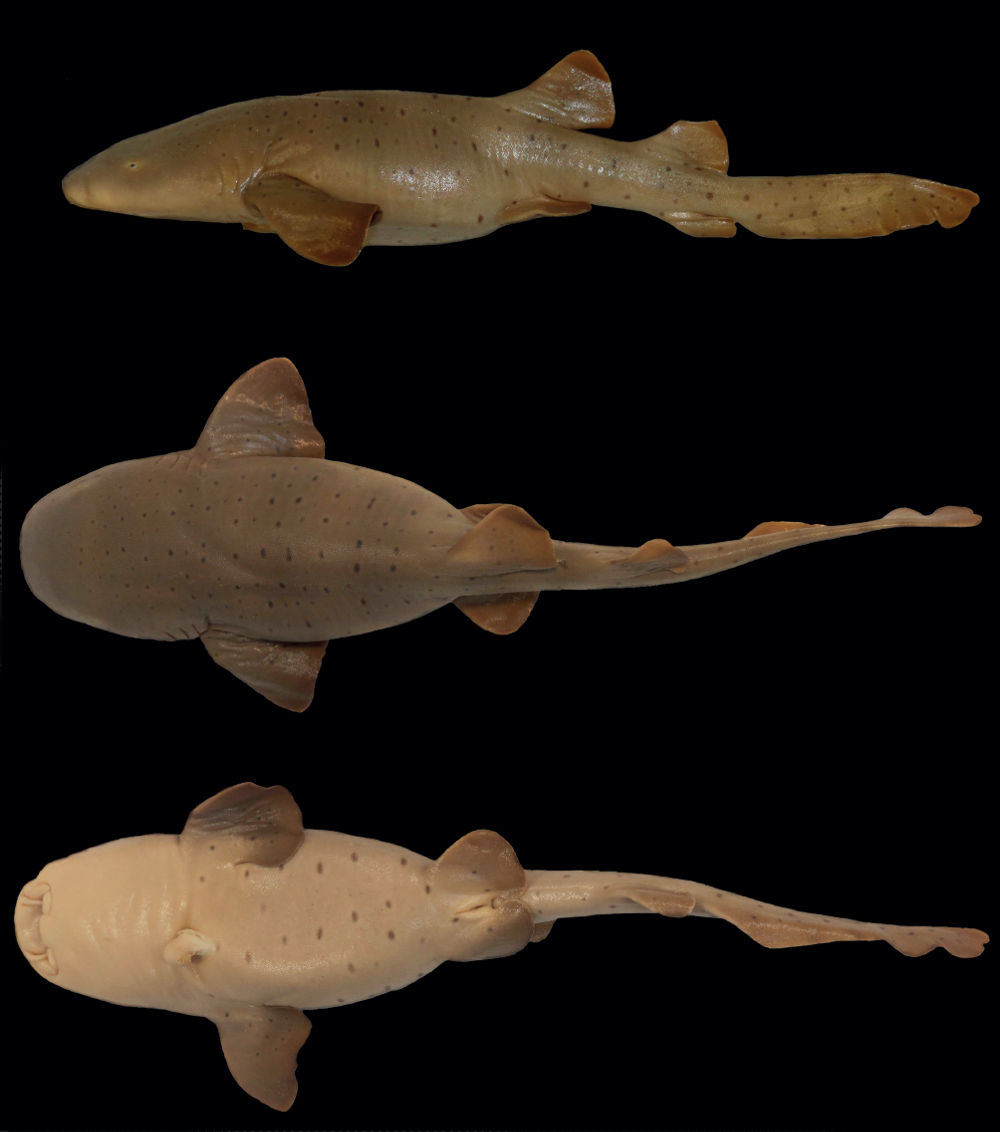
Ginglymostoma unami sp. nov, embryo (CPFES-I-155, 26.6 cm LT): A: lateral; B: dorsal; C: ventral. In: DEL MORAL-FLORES, L.F. & RAMÍREZ-ANTONIO, E. & ANGULO, A. & PÉREZ-PONCE DE LEÓN, G. 2015 Ginglymostoma unami sp. nov. (Chondrichthyes: Orectolobiformes: Ginglymostomatidae): una especie nueva de tiburón gata del Pacífico oriental tropical. Revista Mexicana de Biodiversidad, 86: 48-58

Ginglymostoma unami sp. nov, embryo (CPFES-I-155, 26.6 cm LT): A: lateral; B: dorsal; C: ventral. In: DEL MORAL-FLORES, L.F. & RAMÍREZ-ANTONIO, E. & ANGULO, A. & PÉREZ-PONCE DE LEÓN, G. 2015 Ginglymostoma unami sp. nov. (Chondrichthyes: Orectolobiformes: Ginglymostomatidae): una especie nueva de tiburón gata del Pacífico oriental tropical. Revista Mexicana de Biodiversidad, 86: 48-58
Types
Ginglymostoma unami
Holotype: CNP-IBUNAM: 18850; Paratype: CNP-IBUNAM: 9492; UCR: 3011-01; UCR: 0880-1; UCR: 0025-16; UCR: 0200-23; UNAM: CPFES-I-155;
Ginglymostoma unami
Holotype: CNP-IBUNAM: 18850; Paratype: CNP-IBUNAM: 9492; UCR: 3011-01; UCR: 0880-1; UCR: 0025-16; UCR: 0200-23; UNAM: CPFES-I-155;
Description :
Citation: Ginglymostoma unami Del Moral-Flores, Ramírez-Antonio, Angulo & Pérez-Ponce De León, 2015: In: Database of modern sharks, rays and chimaeras, www.shark-references.com, World Wide Web electronic publication, Version 01/2026
Please send your images of "Ginglymostoma unami" to info@shark-references.com
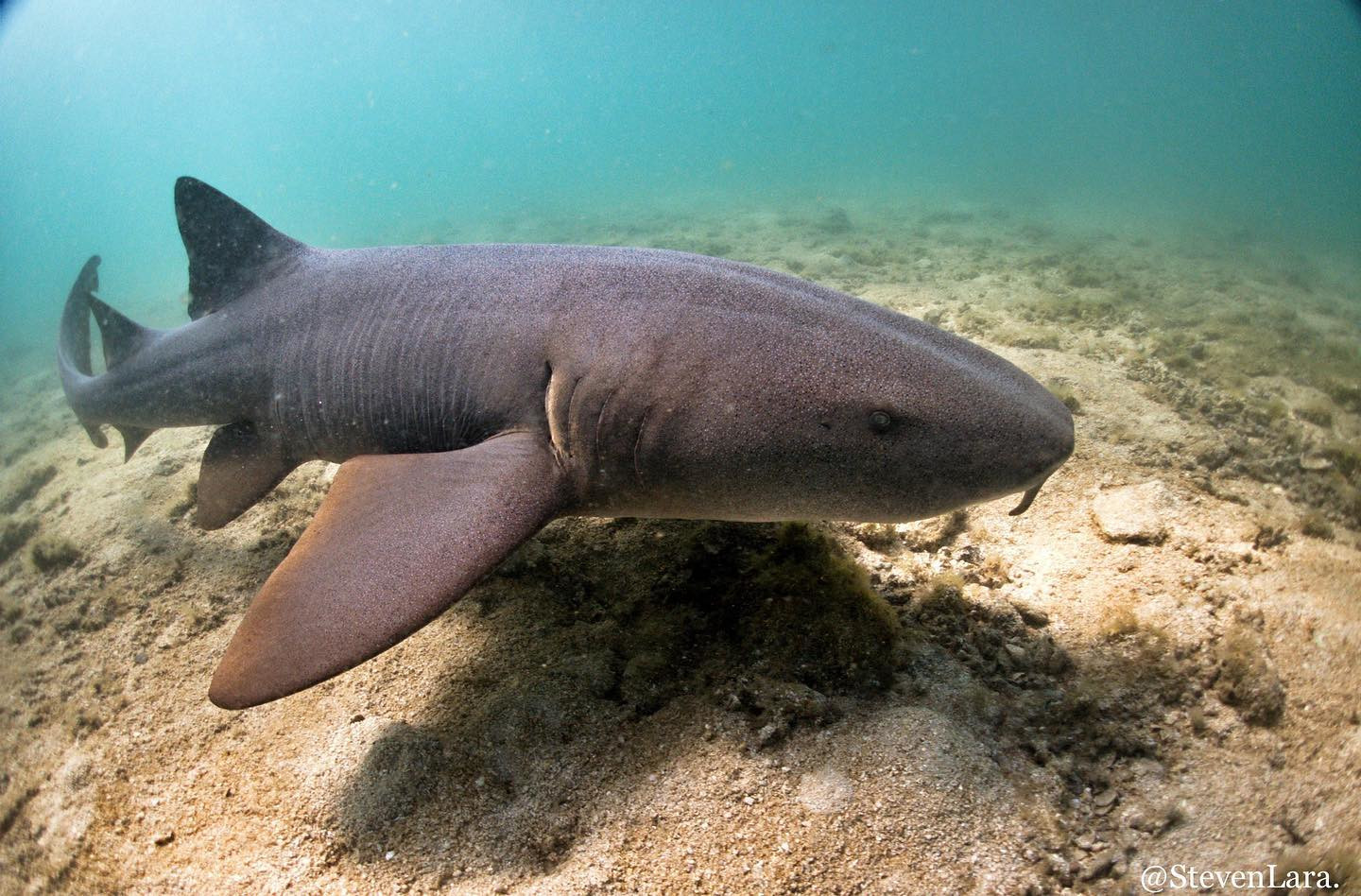
Ginglymostoma unami Del Moral-Flores, Ramírez-Antonio, Angulo & Pérez-Ponce De León, 2015, Gulf of Santa Elena, north Pacific coast of Costa Rica © Steven Lara

Ginglymostoma unami Del Moral-Flores, Ramírez-Antonio, Angulo & Pérez-Ponce De León, 2015, Gulf of Santa Elena, north Pacific coast of Costa Rica © Steven Lara
Short Description
medium size (close to 300 cm TL), Ginglymostoma unami differ from G. cirratum by the distance between the prebanchial and interdorsal regions, and the distance between posterior end of the second dorsal fin and the beginning of the caudal lobe (both being shorter); the new species also differs by the position of the insertion of the first dorsal fin with regard to the pelvic fins and in the form and number of keels on the dermal denticles (with 5-6 keels) and teeth morphology (high central cusp, 4 or more pairs of lateral cusps), teeth formula: 27 to 30, 33 to 35 [22434]
medium size (close to 300 cm TL), Ginglymostoma unami differ from G. cirratum by the distance between the prebanchial and interdorsal regions, and the distance between posterior end of the second dorsal fin and the beginning of the caudal lobe (both being shorter); the new species also differs by the position of the insertion of the first dorsal fin with regard to the pelvic fins and in the form and number of keels on the dermal denticles (with 5-6 keels) and teeth morphology (high central cusp, 4 or more pairs of lateral cusps), teeth formula: 27 to 30, 33 to 35 [22434]
Distribution
endemic, from the south western coast of Baja California, Mexico, to Peru, including the Gulf of California [22434] Source: www.gbif.org
endemic, from the south western coast of Baja California, Mexico, to Peru, including the Gulf of California [22434] Source: www.gbif.org
Dentition
teeth are small, have a central cusp and 4 or more pairs of lateral cusps, upper jaw: 13-15 − 1 − 13-15, lower jaw: 16-18 − 16-18 [22434]
teeth are small, have a central cusp and 4 or more pairs of lateral cusps, upper jaw: 13-15 − 1 − 13-15, lower jaw: 16-18 − 16-18 [22434]
Remarks
shark-references Species-ID=14328;
shark-references Species-ID=14328;
Parasites (arranged by Jürgen Pollerspöck)
Cestoda
Cestoda








